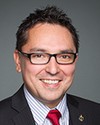Mr. Speaker, I will be sharing my time with the member for Cariboo—Prince George.
I want to thank my colleague from Timmins—James Bay for opening up this opportunity to discuss this important issue tonight.
I rise in the House this evening to lend a voice to a topic which lies heavily on my heart and I know the hearts of all my colleagues on both sides of this chamber. This is not the time to debate what could have been done or what should have been done, but rather, we need to come together with a solution to the issue we are currently facing. There is no time to waste on partisanship when lives are at stake.
Canadians need us to lead by example by coming together and rallying around this hurting community to help them in every possible way. In that spirit, I use the word “discussion” rather than “debate” because I am convinced that the House is eager to take action on the national tragedy that suicide represents.
This is an epidemic that is larger than Attawapiskat and unfortunately, it is growing. It is not okay that the leading causes of death for first nations people under the age of 44 are suicide and self-inflicted injuries. It is not okay that first nations youth die by suicide five to six times more often than non-aboriginal youth. It is not okay that suicide rates for Inuit youth are among the highest in the whole world. This issue needs to light a fire inside all of us to do all that we can to not allow this epidemic to continue.
There are many views on how this is best done, and I share my view from some of the experiences I have accumulated over the past 10 years serving as a member of Parliament. There have been many good steps taken to address this tragic issue of suicide, but much more needs to be done.
As co-chair of the all-party Parliamentary Committee on Palliative and Compassionate Care, I, along with NDP and Liberal colleagues, conducted a study on the complex issue of suicide prevention and our findings are recorded in the report called “Not to be Forgotten”.
What became clear is that suicide is a complex phenomenon with multiple, often intertwining and overlapping causes. The complexity of suicide makes it obvious that solutions cannot be reduced to a mental health approach alone, but must take all aspects of the person into account, including physical, social, cultural, and spiritual factors.
One witness who appeared before our parliamentary committee was Dr. Antoon Leenaars, a psychologist and suicide researcher. He shared with the committee:
Suicide is multi-determined. The common psychological factors...are unbearable pain, cognitive constriction or tunnel vision, ambiguities about life and death, a mental health disorder, a weakened ego, a disturbance in a relationship or some other ideal like one's health or youth, rejection-aggression, and a desire to escape. This complexity calls for diverse suicide prevention strategies. This is necessary to not only solve what is sometimes assumed to be primarily a “medical problem”, but also to address the deep taboo and its stigma, and to address the problem with specific vulnerable groups, such as First Nations and Inuit people, armed services personnel, youth, and elderly (especially those facing end of life issues). The complexity of suicide dictates the necessity of a parallel complexity of solutions. There is never the solution. Therefore not only a mental health approach, but a public health approach, is urgently needed.
Research done by the Royal Commission on Aboriginal Peoples, as recorded in our committee report, found that the culture of first nations peoples was thrown into turmoil by the policies of colonialism. In this report it was clear that the whole complex of relationships, knowledge, languages, social institutions, beliefs, values and ethical rules that bind people together and give a collection of people and its individual members a sense of who they are and where they belong plays a profound role in mental health and well-being.
Prior to the breakdown of their culture, suicide was rare among first nations people. However, as I previously stated, today, suicide among first nations youth is at epidemic proportions. The development of a sense of healthy identity is profoundly related to one's culture and its ability to reproduce itself in its members. Thus the anthropological and sociological dimensions can have a deep impact upon the psychological.
It is important to be reminded that suicide intervention really does work and many lives are saved every year. Despite this fact, Canadian response is mainly due to the efforts of individuals and private groups who strive against the tide with very few resources. We have many great examples of local groups across Canada that are doing heroic work in preventing suicide.
When I first heard the news of the 11 suicide attempts in Attawapiskat, my heart sank and I immediately remembered an incident from 2011 when I was contacted by Tana Nash of the Waterloo Region Suicide Prevention Council. She informed me of the fact that three suicides had occurred in three different high schools in Waterloo region in one week. Help was urgently needed. At that moment, I knew that I wanted to do something to deal with issues; albeit, I knew my attempts would be less than adequate. I knew that something must be done to address the tragic loss of hope, especially among our young people. To that end, I embarked upon drafting Bill C-300, an act respecting a federal framework for suicide prevention.
As a nation, we have not done enough to implement a coherent program of suicide prevention. Some provinces have begun to make great strides, especially Quebec. Yet, in general, efforts to prevent suicide are still a patchwork, depending upon the generosity of individuals, many of whom have been personally impacted by suicide.
This is why it is so urgent that the government implement the federal framework on suicide prevention as soon as possible. With its immediate implementation, we would be able to give to the groups on the ground the much needed tools and resources they so desperately need.
When fully implemented, Bill C-300, through the Public Health Agency of Canada, would provide guidelines to improve public awareness and knowledge about suicide. It would disseminate information about suicide, including information concerning its prevention. It would make publicly available existing statistics about suicide and related risk factors. This is one of the weak points that many of the groups which came to our committee pointed out: the statistics relating to suicide are so old and so out of date that there is really no way to plan forward in going ahead. The bill would promote collaboration and knowledge exchange across domains, sectors, regions, and jurisdictions. It would define best practices for the prevention of suicide. It would promote the use of research and evidence-based practices for the prevention of suicide.
The principles embodied in Bill C-300 could be contextualized and individualized to communities, depending upon their unique circumstances. I want to underline that fact. This is not a bill that would tell communities how to do it. My colleague earlier pointed out that we need to give communities the ability to contextualize within their own communities.
Furthermore, safeTALK training for all front-line service workers and volunteers on reserve would be a major investment in proactive prevention of suicide. Community members, such as teachers, doctors, nurses, coaches, pastors, club leaders, and many more, are in a unique position to recognize the early warning signs and would be able to ask the right questions that could very well lead to saving a life.
I am certain that everyone in this chamber can tell us how they, their families, or a member in their community, has been negatively impacted by suicide. Each of us knows someone whose sense of hope was overcome by despair and who ended his or her life by suicide. However, we know that suicide does not end the pain. It simply transfers it to the family, to the friends, and to the community.
This particular community that we are discussing tonight is currently in extreme pain. Now is the time to do all that we can to deliver hope.
Evidence is accumulating that when aboriginal communities design their own interventions, typically based upon traditional cultural values and practices, the efficacy of these interventions is high. Therefore, there is hope, but much more needs to be done. We need to offer hope to those who are facing this unbearable pain and who subsequently descend into a state of hopelessness and despair.
Hope is dependent upon having a sense of connection to the future, even if that future is short term. Hope is the oxygen of the human spirit. Without it, the spirit dies.
I am a person of hope. The very fact that this important discussion is happening tonight in the House of Commons in Canada is a huge step forward in providing hope.
We stand with our brothers and sisters in Attawapiskat to provide immediate practical help. We want them to know that they are in our thoughts and prayers. I pray they will know that their lives have value and meaning, that they are loved by their families, their friends, their fellow Canadians, and their Creator.















